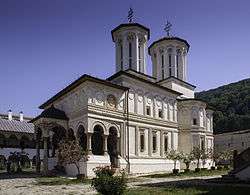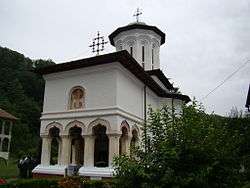Brâncovenesc style
The Brâncovenesc style /brɨŋkovenesk/, also known as Wallachian Renaissance and Romanian Renaissance, is an art and architectural style that evolved during the administration of Prince Constantin Brâncoveanu in the late 17th and early 18th centuries.[1] Brâncoveanu was an administrator of the Principality of Wallachia (between 1688 and 1714) under Ottoman Empire overlords, an extremely wealthy aristocrat, and a builder of fine palaces and churches.[1][2]

.jpg)

Description
The design style developed in Wallachia, in present day southern Romania. Brâncovenesc style is synthesis between the Byzantine, Ottoman, late Renaissance, and Baroque architecture. It was also a unique hybrid of Romanian Orthodox Christian ediface styles working with the dominant Islamic architecture of the Ottoman Empire, of which the Principality of Wallachia was then, as a vassal state, an integral part.[2] The most accomplished and the best preserved example of Brâncovenesc style architecture is Horezu monastery, inscribed by UNESCO on its list of World Heritage Sites, where Brâncoveanu intended to have his tomb.
Neo-Brâncovenesc
The Brâncovenesc style inspired architect Ion Mincu and others to initiate the Neo-Brâncovenesc/Neo-Romanian architectural style in the latter 19th century.[1][2]
Examples
Examples of buildings in the Brâncovenesc style include:
- Arnota Monastery
- Brâncoveanu Monastery
- Cozia Monastery
- Govora Monastery [3]
- Horezu Monastery
- Potlogi Palace [4]
- Surpatele Monastery [5]
- Sinaia Monastery
- Văcăreşti Monastery — demolished, frescos salvaged.
- In Bucharest examples include:
- Cotroceni Palace
- Kretzulescu Church
- Mogoşoaia Palace
- St. George the New Church
- Stavropoleos Monastery
See also
- Romanian architecture
- Constantin Brâncoveanu
- Ion Mincu — Neo-Brâncovenesc/Neo-Romanian architect.
- Toma T. Socolescu — Neo-Brâncovenesc/Neo-Romanian architect.
References
- Historic Houses of Romania blog: "Brancovenesc Style" Archived 2014-08-12 at the Wayback Machine . Valentin Mandache's weblog . accessed 10.8.2013
- Historic Houses of Romania blog: "Brief consideration on the Brancovan style architecture" Archived 2013-10-14 at the Wayback Machine . Valentin Mandache's weblog . accessed 10.8.2013
- Romanian-monasteries.go.ro: Govora Monastery Archived September 30, 2011, at the Wayback Machine
- Historo.wordpress.com: Potlogi Palace
- Mănăstirea_Surpatele (in Romanian)